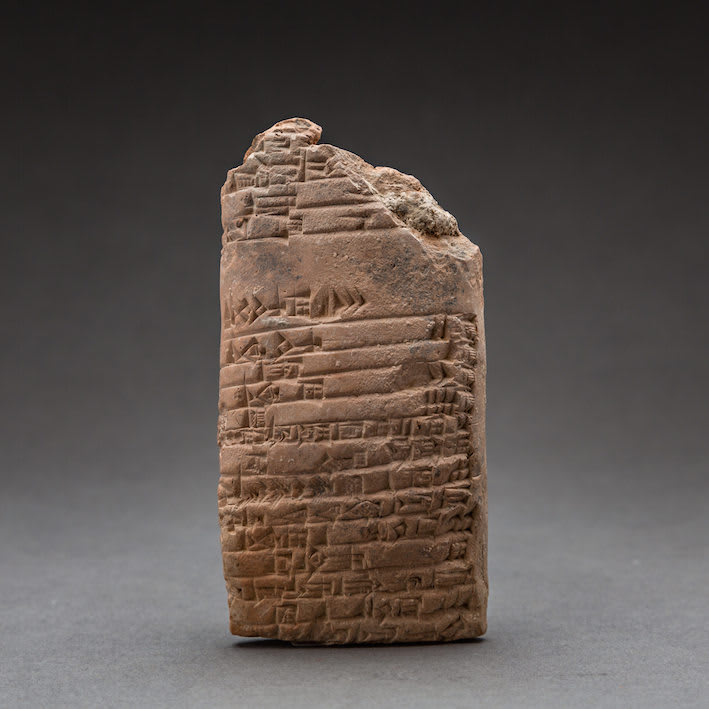Cuneiform Tablet, 2029 BCE - 2024 BCE
Clay
11.8 x 5.9 cm
4 5/8 x 2 3/8 in
4 5/8 x 2 3/8 in
LSO.27
Clay Tablet, with 35 lines of Sumerian Cuneiform writin The top of the tablet is incomplete, and while not much is missing several lines cannot be clearly read. It is...
Clay Tablet, with 35 lines of Sumerian Cuneiform writin The top of the tablet is incomplete, and while not much is missing several lines cannot be clearly read.
It is an administrative document from the period of the Third Dynasty of Ur, with remains of date from the reign of Ibbi-Sin, last king of the dynasty, c.
2029-2004 BC. It contains a listing of flocks of sheep and goats with numbers of each type given, and the shepherd in charge, with some indication of owners at the end. Translation: ……] …120 billy goats: Shu-ili, herde 1200 sheep, 180 rams, 60 male kids: Nuh-ilum, herder 600 sheep, 120 billy goats: Ushu-kin, herder 900 sheep, 180 rams: Erra-palik, herder 240 sheep, 60 rams:…gu……, herder 300 sheep, 60 rams: Ilum-rabi, sheep of Ninshaga 2100 sheep, 180 ewes, 240 rams:……zi, herder 1140 sheep, 120 ewes, 120 rams: Inazzir, herder 240 sheep, 60 ewes: Imdada, herder 180 sheep, 60 ewes,: Ur-Shulpa’e, herder, sheep of the governor 300 sheep, 60 rams: Madah-ili, herder 300 sheep, 60 ewes: Mumu, herder, sheep of Ninbaragesi 600 sheep, 120 ewes: Ipqusha, herder, sheep of Halhalla (?)
Total: 480 ewe Total: 60 kid Total: 120 billy goat 112, 600* (*or 1860) … ] …
… …] …
[The year: Ib]bi-Si [king of U]
*** The figures and the totals cause us problems. A few lines are missing at the top, so one could expect our additions to result in fewer than the ancient totals at times but the opposite occurs with the ewes. What appears to be the grand total is also problematic.
Unless the missing lines had very large numbers, “112, 600” is too big a grand total. Since Sumerians had no symbol for “zero” one could read the grand total as 1860, but that is much too small, Perhaps the scribe was not too careful, since all the individuals groups have obviously approximate numbers. And no one would ever see all these animals together.
It is an administrative document from the period of the Third Dynasty of Ur, with remains of date from the reign of Ibbi-Sin, last king of the dynasty, c.
2029-2004 BC. It contains a listing of flocks of sheep and goats with numbers of each type given, and the shepherd in charge, with some indication of owners at the end. Translation: ……] …120 billy goats: Shu-ili, herde 1200 sheep, 180 rams, 60 male kids: Nuh-ilum, herder 600 sheep, 120 billy goats: Ushu-kin, herder 900 sheep, 180 rams: Erra-palik, herder 240 sheep, 60 rams:…gu……, herder 300 sheep, 60 rams: Ilum-rabi, sheep of Ninshaga 2100 sheep, 180 ewes, 240 rams:……zi, herder 1140 sheep, 120 ewes, 120 rams: Inazzir, herder 240 sheep, 60 ewes: Imdada, herder 180 sheep, 60 ewes,: Ur-Shulpa’e, herder, sheep of the governor 300 sheep, 60 rams: Madah-ili, herder 300 sheep, 60 ewes: Mumu, herder, sheep of Ninbaragesi 600 sheep, 120 ewes: Ipqusha, herder, sheep of Halhalla (?)
Total: 480 ewe Total: 60 kid Total: 120 billy goat 112, 600* (*or 1860) … ] …
… …] …
[The year: Ib]bi-Si [king of U]
*** The figures and the totals cause us problems. A few lines are missing at the top, so one could expect our additions to result in fewer than the ancient totals at times but the opposite occurs with the ewes. What appears to be the grand total is also problematic.
Unless the missing lines had very large numbers, “112, 600” is too big a grand total. Since Sumerians had no symbol for “zero” one could read the grand total as 1860, but that is much too small, Perhaps the scribe was not too careful, since all the individuals groups have obviously approximate numbers. And no one would ever see all these animals together.



